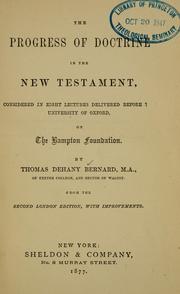Check nearby libraries
Buy this book

The book comprises the Bampton Lecture series delivered to the students and faculty at Oxford in 1864 by Thomas Dehaney Bernard. Wilbur Smith called the Bampton Lectures “the oldest and most famous lectureship in the field of theology and biblical interpretation in the English world.” And one of the most famous of the Bampton Lectures (along with Liddon’s classic on the deity of Christ two years later) is Bernard’s. The table of contents outlines the structure of each lecture in preview, and that outline is built into each lecture as well.
Bernard’s treatment is premised on the argument (Lecture 1) that the order of the New Testament corpora—Gospels, Acts, Epistles, and Revelation—is not the product of caprice, accident, or random organization, but of providential superintendence. To organize a presentation of NT doctrine along these lines, let alone posit a detectable theological progression within that framework, may strike some as artificial, even naïve. But if we believe that God has providentially guided the translation and preservation of His word over the centuries, it is hardly unreasonable that He would have an interest and hand in the form in which it has been almost uniformly preserved. Moreover, when viewed in the light of this canonical-corporal framework, the NT displays a remarkable doctrinal progression in terms of both content and teaching method.
Lectures 2 and 3 focus on the Gospels’ introduction of the person of Jesus Christ. Within this fourfold variation, Bernard demonstrates a progression not only from the Synoptics to John’s gospel but even from one gospel to the next. Yet the Gospels raise a raft of issues and questions that they are not designed to answer. Indeed, “the evangelical narrative creates the want [need] and gives the pledge of an evangelical doctrine” to come later in the NT. Even as the teaching of Christ reaches its highest stage of revelation (John 13-17), it “declares its own incompleteness and refers us to another stage of instruction” yet to come (see Jn. 16:12-15).
Lectures 4 and 5 are devoted to Acts as the next stage of revelation. Acts functions as a crucial bridge, both historically and doctrinally, between the introduction of the facts and teaching of Jesus in the Gospels and the interpretation of those facts and teachings in the Epistles.
Lectures 6 and 7 not only highlight the pedagogical genius of the epistolary literature, but also showcase Bernard’s ability to slice to the bone and expose the marrow of apostolic doctrine. Lecture 8 traces the major thematic threads out of which the Apocalypse is woven, as it unfolds the consummation of the person and work of Christ.
Bernard’s big-picture grasp of how the NT functions pedagogically is unmatched. His lectures flicker with flashes of brilliant insight. Even the key text selected for each lecture displays remarkable perception. Above all, few modern theological works breathe the rich devotional air that animates Bernard’s lectures. Through his knowledge of the Scriptures, Bernard has entered not only into the mind of God but the heart of God. It is one of those works that bears rereading at least every five years to reorient you to the whole forest of the NT lest you lose your bearings among the individual trees.
Layton Talbert, PhD
Professor of Theology & Exposition
Bob Jones Seminary & Graduate School of Religion
Greenville, SC
Check nearby libraries
Buy this book

Previews available in: English
Subjects
Bible, Theology, English SermonsShowing 7 featured editions. View all 12 editions?
| Edition | Availability |
|---|---|
|
1
The progress of doctrine in the New Testament: considered in eight lectures preached before the University of Oxford on the Bampton foundation
1877, Sheldon & Company
in English
- 2d London ed., with improvements.
|
aaaa
Libraries near you:
WorldCat
|
| 2 |
bbbb
|
|
3
The progress of doctrine in the New Testament: considered in eight lectures preached before the University of Oxford on the Bampton foundation
1872, Gould and Lincoln
Microform
in English
- From the 2nd London ed., with improvements.
|
bbbb
Libraries near you:
WorldCat
|
| 4 |
bbbb
Libraries near you:
WorldCat
|
|
5
The progress of doctrine in the New Testament: considered in eight lectures preached before the University of Oxford on the Bampton foundation
1867, Gould and Lincoln
in English
- From the 2d London ed., with improvements.
|
bbbb
Libraries near you:
WorldCat
|
| 6 |
bbbb
|
| 7 |
bbbb
|
Book Details
Published in
New York
Edition Notes
The Physical Object
ID Numbers
Community Reviews (0)
Feedback?| November 23, 2012 | Edited by Anand Chitipothu | Reverted spam |
| November 23, 2012 | Edited by 188.190.126.67 | Edited without comment. |
| August 8, 2012 | Edited by ImportBot | import new book |
| December 3, 2010 | Edited by Open Library Bot | Added subjects from MARC records. |
| December 10, 2009 | Created by WorkBot | add works page |















